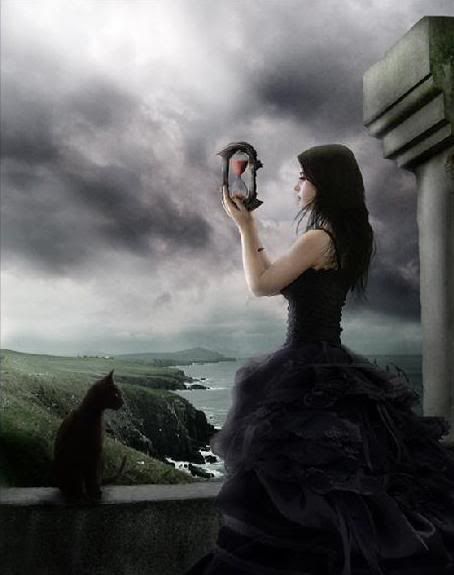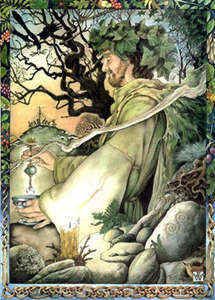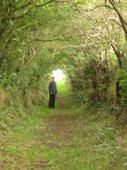Post by KittyLane on Apr 4, 2006 17:03:41 GMT -5
Especially for Solitary Work:
A Witch Alone: Thirteen Moons to Master Natural Magic; Marian Green - One of the best books for a new solitary in print. This is one of the few that doesn't immediately dunk you into a ritual practice that's out of context for you, instead leading you through the basic considerations of a relationship with the natural world and simple exercises that will build a foundation for a solid practice. Marian Green is one of the most long-standing, informed, and responsible authors in print (and out of print) - and is one of the most universally recommended by both Traditional and non-Traditional teachers.
The Wiccan Path: A Guide for the Solitary Practitioner (also published as "Hedge Witch"); Rae Beth - Written in the form of letters to and lessons for her two apprentices, this book has a feel of sitting down over a cup of coffee with someone you like. In addition to solid information, suggestions are also given for adapting practices and rituals to your personal style. The letters are warm, heart-felt, and make a personal practice accessible without watering down essential concepts.
Wheel of the Year: Living the Magical Life; Pauline Campanelli - Organized month-by-month, this covers not only the major festivals but also tidbits of history and folklore as well as day-to-day activities and crafts to mark the seasons.
Witchcraft for Tomorrow; Doreen Valiente - This book has two sections - an introduction to Craft, and a sample 'Book of Shadows' to work with in developing a personal practice. The type of practice presented is much closer to a Traditional style than that presented by Scott Cunningham, Silver Ravenwolf, or many other popular authors.
Introductions:
What Witches Do; Stewart Farrar - Written shortly after his initiation, this is a look into the 'inner life' of a practicing witch and coven done by a skilled journalist. 30 years later, it's still a wonderful glimpse into the 'feel' of Traditional Wicca in a very personal way.
Wicca: The Old Religion in the New Millennium (also published as "Wicca"); Vivianne Crowley - Recently reprinted without the subtitle, this is one of the better introductions to currently available. Although her background in Jungian psychology strongly colors many of her views, a solid context for many aspects of Wiccan practice is presented along with personal perspectives.
Lid Off the Cauldron; Patricia Crowther - Written by one of Gardner's last High Priestesses, this covers a bit of relevant history as well as an introduction to the public basics of older practice in an easy-to-read style full of personal stories and anecdotes.
The Heart of Wicca: Wise Words from a Crone on the Path; Ellen Cannon Reed - This book talks about what it means to follow an initiatory mystery path, rather than just another religion. It goes beyond many of the currently popularized ideas and images related to the nature of Wiccan beliefs and practices and dives into a deeper understanding of the lifestyle, mind set, and religious dedication that lie at the heart of Traditional Wicca. As one elder has said, "If you still want to learn about Traditional-style Wicca when you're done with this book, then you may be successful. And if you find that you disagree with many of the things she says, then you will probably not be happy on a Traditional path."
When, Why... If; Robin Wood - One of the best introductions to magical and personal ethics currently in print. Easy to read and friendly, yet this book packs a good punch - it doesn't tell you what to think, but instead encourages exploration of our own thoughts and and standards. The journal exercises at the end of each chapter walk you through the steps of creating a solid ethical system for yourself.
Foundations:
Witchcraft Today; Gerald Gardner - Gerald Gardner's first public work on witchcraft, this was published in 1953 and it still provides the best publicly available insights into Traditional Craft. Although some points of history have changed in recent years, Gardner utilizes the best available information of his time in an overview of British Witchcraft. This is not a 'how-to' - it is a glimpse into a different worldview that still underlies all Traditional Wicca.
The Meaning of Witchcraft; Gerald Gardner - Much denser than "Witchcraft Today", this goes further than Gardner's original work on witchcraft. Although the organizational style can be somewhat tedious, the information and opinions are invaluable. This is a must-read for any serious student of Traditional Craft.
A Grimoire of Shadows; Ed Fitch - This is an expanded version of material originally written for students waiting to be accepted into an outer court or training coven. Rituals in a Traditional style are provided, as well as training exercises that develop skills needed in most Traditional systems.
History and Mythology:
The Ancient Brittish Goddess: Her Myths, Legends, Sacred Sites and Present Day Revelation; Kathy Jones - Beautifully illustrated and photographed, several British concepts of Goddess are introduced, along with retellings of associated native myths and stories.
The History of Pagan Europe; Prudence Jones and Nigel Pennick - A solid scholarly overview of the history of European Pagan religions that still manages to be an interesting read. Well-illustrated and concise, threads from Greek and Roman origins are traced through the current Pagan revival.
Drawing Down the Moon: Witches, Druids, Goddess-Worshipers & Other Pagans in America Today (20th Anniv. Ed); Margot Adler - This book is the end result of five years of research and interviews. Updated in 1986 and 1997, this landmark study is the single most comprehensive study of modern American Paganism in existence. It can be rather dry at times, but is considered a solid foundation of recent history and a good overview of many Pagan paths. Note, however, that the discussions of specific organizations and some other topics have inevitably become somewhat dated.
Personal Development:
Life's Companion: Journal Writing as a Spiritual Quest; Christina Baldwin - Personal record-keeping and journaling are essential to developing a strong spiritual practice. This volume combines a journaling how-to with creative exercises, examples and meditations, and has been a standard in a number of educational programs, as well as spiritual paths from many (pagan and non-pagan) systems for over a decade. The meditations are also available on a companion tape.
The Seven Habits of Highly Effective People; Stephen R Covey - Although not written from a spiritual point of view, the integrated principle-centered descriptions of the seven Habits - especially the first three - are the some of the easiest-to-understand descriptions of the most fundamental requirements for self-change (and magic).
After the Ecstasy, the Laundry; Jack Kornfield - Using amusing anecdotes and interviews with highly accomplished teachers, abbots, and lamas, the author shatters most perfectionistic misconceptions about what life is like after enlightenment.
Other Associated Topics:
Tarot for Yourself: A Workbook for Personal Transformation; Mary K Greer - A standard introduction for many years, this utilizes many different approaches to teach tarot fundamentals for tarot reading as well as utilizing the tarot for self-development.
Tarot Plain and Simple; Anthony Louis - For the beginner, the author covers symbolism and interpretation in, well, plain and simple language. For the more advanced reader this is probably one of the most concise references. The illustrations are from the Robin Wood Tarot deck.
Divination for Beginners: Reading the Past, Present & Future (formerly "the Art of Divination"); Scott Cunningham - Written for those new to divination and recently re-released under a new title, this provides an overview of many different methods and approaches. Basics of a number of systems are covered - including several that are not commonly discussed - providing a good resource to explore the many options available.
Astrology for the Light Side of the Brain; Kim Rogers-Gallagher - A small and rather irreverent book that will keep you chuckling as it covers the basics of planets, houses, signs and aspects. Not a comprehensive guide, but a solid introduction that is easy to learn from.
Fiction:
Bell, Book and Murder; Rosemary Edgehill - An omnibus reprint of the three Bast mysteries ("Speak Daggers to Her", "Book of Moons", and "Bowl of Night"), where the leading character is a real Wiccan, instead of a Hollywood witch. The mysteries are a bit simple for those who love deep, twisted plots, but the realism of day-to-day life as a witch, and the wry commentary on the Pagan community is more than worth the read.
Greenmantle; Charles deLint - An urban fantasy set in a world of mists and forests, of ancient magics, mythical beings, ageless bards... and restless evil. The story follows the encounter - and what follows - of a Mystery who walks in moonlight and is chased by the hunt.
The Earthsea Quartet; Ursula K LeGuin - An omnibus reprint of the first four Earthsea books ("A Wizard of Earthsea", "The Tombs of Atuan", "The Farthest Shore", and "Tehanu"). A coming-of-age saga that offers a challenging perspective about the power of language, and how in the act of naming the world around us we actually create that world.
A Witch Alone: Thirteen Moons to Master Natural Magic; Marian Green - One of the best books for a new solitary in print. This is one of the few that doesn't immediately dunk you into a ritual practice that's out of context for you, instead leading you through the basic considerations of a relationship with the natural world and simple exercises that will build a foundation for a solid practice. Marian Green is one of the most long-standing, informed, and responsible authors in print (and out of print) - and is one of the most universally recommended by both Traditional and non-Traditional teachers.
The Wiccan Path: A Guide for the Solitary Practitioner (also published as "Hedge Witch"); Rae Beth - Written in the form of letters to and lessons for her two apprentices, this book has a feel of sitting down over a cup of coffee with someone you like. In addition to solid information, suggestions are also given for adapting practices and rituals to your personal style. The letters are warm, heart-felt, and make a personal practice accessible without watering down essential concepts.
Wheel of the Year: Living the Magical Life; Pauline Campanelli - Organized month-by-month, this covers not only the major festivals but also tidbits of history and folklore as well as day-to-day activities and crafts to mark the seasons.
Witchcraft for Tomorrow; Doreen Valiente - This book has two sections - an introduction to Craft, and a sample 'Book of Shadows' to work with in developing a personal practice. The type of practice presented is much closer to a Traditional style than that presented by Scott Cunningham, Silver Ravenwolf, or many other popular authors.
Introductions:
What Witches Do; Stewart Farrar - Written shortly after his initiation, this is a look into the 'inner life' of a practicing witch and coven done by a skilled journalist. 30 years later, it's still a wonderful glimpse into the 'feel' of Traditional Wicca in a very personal way.
Wicca: The Old Religion in the New Millennium (also published as "Wicca"); Vivianne Crowley - Recently reprinted without the subtitle, this is one of the better introductions to currently available. Although her background in Jungian psychology strongly colors many of her views, a solid context for many aspects of Wiccan practice is presented along with personal perspectives.
Lid Off the Cauldron; Patricia Crowther - Written by one of Gardner's last High Priestesses, this covers a bit of relevant history as well as an introduction to the public basics of older practice in an easy-to-read style full of personal stories and anecdotes.
The Heart of Wicca: Wise Words from a Crone on the Path; Ellen Cannon Reed - This book talks about what it means to follow an initiatory mystery path, rather than just another religion. It goes beyond many of the currently popularized ideas and images related to the nature of Wiccan beliefs and practices and dives into a deeper understanding of the lifestyle, mind set, and religious dedication that lie at the heart of Traditional Wicca. As one elder has said, "If you still want to learn about Traditional-style Wicca when you're done with this book, then you may be successful. And if you find that you disagree with many of the things she says, then you will probably not be happy on a Traditional path."
When, Why... If; Robin Wood - One of the best introductions to magical and personal ethics currently in print. Easy to read and friendly, yet this book packs a good punch - it doesn't tell you what to think, but instead encourages exploration of our own thoughts and and standards. The journal exercises at the end of each chapter walk you through the steps of creating a solid ethical system for yourself.
Foundations:
Witchcraft Today; Gerald Gardner - Gerald Gardner's first public work on witchcraft, this was published in 1953 and it still provides the best publicly available insights into Traditional Craft. Although some points of history have changed in recent years, Gardner utilizes the best available information of his time in an overview of British Witchcraft. This is not a 'how-to' - it is a glimpse into a different worldview that still underlies all Traditional Wicca.
The Meaning of Witchcraft; Gerald Gardner - Much denser than "Witchcraft Today", this goes further than Gardner's original work on witchcraft. Although the organizational style can be somewhat tedious, the information and opinions are invaluable. This is a must-read for any serious student of Traditional Craft.
A Grimoire of Shadows; Ed Fitch - This is an expanded version of material originally written for students waiting to be accepted into an outer court or training coven. Rituals in a Traditional style are provided, as well as training exercises that develop skills needed in most Traditional systems.
History and Mythology:
The Ancient Brittish Goddess: Her Myths, Legends, Sacred Sites and Present Day Revelation; Kathy Jones - Beautifully illustrated and photographed, several British concepts of Goddess are introduced, along with retellings of associated native myths and stories.
The History of Pagan Europe; Prudence Jones and Nigel Pennick - A solid scholarly overview of the history of European Pagan religions that still manages to be an interesting read. Well-illustrated and concise, threads from Greek and Roman origins are traced through the current Pagan revival.
Drawing Down the Moon: Witches, Druids, Goddess-Worshipers & Other Pagans in America Today (20th Anniv. Ed); Margot Adler - This book is the end result of five years of research and interviews. Updated in 1986 and 1997, this landmark study is the single most comprehensive study of modern American Paganism in existence. It can be rather dry at times, but is considered a solid foundation of recent history and a good overview of many Pagan paths. Note, however, that the discussions of specific organizations and some other topics have inevitably become somewhat dated.
Personal Development:
Life's Companion: Journal Writing as a Spiritual Quest; Christina Baldwin - Personal record-keeping and journaling are essential to developing a strong spiritual practice. This volume combines a journaling how-to with creative exercises, examples and meditations, and has been a standard in a number of educational programs, as well as spiritual paths from many (pagan and non-pagan) systems for over a decade. The meditations are also available on a companion tape.
The Seven Habits of Highly Effective People; Stephen R Covey - Although not written from a spiritual point of view, the integrated principle-centered descriptions of the seven Habits - especially the first three - are the some of the easiest-to-understand descriptions of the most fundamental requirements for self-change (and magic).
After the Ecstasy, the Laundry; Jack Kornfield - Using amusing anecdotes and interviews with highly accomplished teachers, abbots, and lamas, the author shatters most perfectionistic misconceptions about what life is like after enlightenment.
Other Associated Topics:
Tarot for Yourself: A Workbook for Personal Transformation; Mary K Greer - A standard introduction for many years, this utilizes many different approaches to teach tarot fundamentals for tarot reading as well as utilizing the tarot for self-development.
Tarot Plain and Simple; Anthony Louis - For the beginner, the author covers symbolism and interpretation in, well, plain and simple language. For the more advanced reader this is probably one of the most concise references. The illustrations are from the Robin Wood Tarot deck.
Divination for Beginners: Reading the Past, Present & Future (formerly "the Art of Divination"); Scott Cunningham - Written for those new to divination and recently re-released under a new title, this provides an overview of many different methods and approaches. Basics of a number of systems are covered - including several that are not commonly discussed - providing a good resource to explore the many options available.
Astrology for the Light Side of the Brain; Kim Rogers-Gallagher - A small and rather irreverent book that will keep you chuckling as it covers the basics of planets, houses, signs and aspects. Not a comprehensive guide, but a solid introduction that is easy to learn from.
Fiction:
Bell, Book and Murder; Rosemary Edgehill - An omnibus reprint of the three Bast mysteries ("Speak Daggers to Her", "Book of Moons", and "Bowl of Night"), where the leading character is a real Wiccan, instead of a Hollywood witch. The mysteries are a bit simple for those who love deep, twisted plots, but the realism of day-to-day life as a witch, and the wry commentary on the Pagan community is more than worth the read.
Greenmantle; Charles deLint - An urban fantasy set in a world of mists and forests, of ancient magics, mythical beings, ageless bards... and restless evil. The story follows the encounter - and what follows - of a Mystery who walks in moonlight and is chased by the hunt.
The Earthsea Quartet; Ursula K LeGuin - An omnibus reprint of the first four Earthsea books ("A Wizard of Earthsea", "The Tombs of Atuan", "The Farthest Shore", and "Tehanu"). A coming-of-age saga that offers a challenging perspective about the power of language, and how in the act of naming the world around us we actually create that world.










 A Christian board might be interesting; I doubt I could do it justice, but I'd love to hear other's opinions
A Christian board might be interesting; I doubt I could do it justice, but I'd love to hear other's opinions
 I have found it really hard to find a book based solely on the study of the goddess.
I have found it really hard to find a book based solely on the study of the goddess. 
